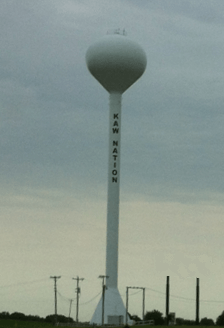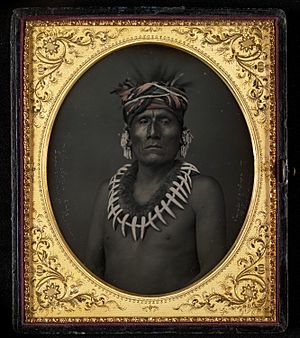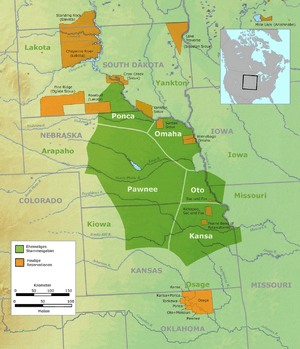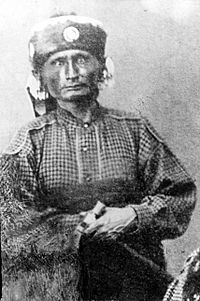Kaw people facts for kids
| Total population | |
|---|---|
| 3,559 | |
| Regions with significant populations | |
| United States ( ) | |
| Languages | |
| English, historically Kansa | |
| Religion | |
| Native American Church, Christianity, traditional tribal religion | |
| Related ethnic groups | |
| other Siouan and Dhegihan peoples |
The Kaw Nation (also called Kanza or Kansa) is a Native American tribe officially recognized by the United States government. They live in Oklahoma and parts of Kansas.
The Kaw people used to live in the central Midwestern United States. They are also known as the "People of the South Wind" or "People of Water." Their language, Kansa, is part of the Siouan language family.
The state of Kansas is named after this tribe. The capital city of Kansas, Topeka, gets its name from the Kaw word Tó Ppí Kˀé, which means "a good place to grow potatoes." The Kaw are closely related to the Osage Nation, and members of both tribes often married each other.
Contents
How the Kaw Nation Works
The Kaw Nation runs many businesses and services that help its people and the local area. The tribe's yearly economic impact is about $200 million.
The Kaw Nation owns several businesses, including:
- Kanza Travel Plaza
- Woodridge Market
- Smoke Shop I and II
- SouthWind Casino, which has a bingo hall and a place for horse race betting
- SouthWind Casino Braman, which opened in 2014
The tribe also operates many important services and departments:
- Kanza Health Clinic
- Kanza Wellness Center
- Kaw Nation School Age Enrichment Center
- Kanza Museum
- Kaw Nation Environmental Department
- Kaw Nation Police Department
- Kaw Nation Social Service and Educational Department
- Kaw Nation Emergency Management Department
- Kaw Language Department
- Kaw Nation Judicial Branch, which includes a program to help with domestic violence
- Kaw Nation Housing Authority
- Tribal library
- Title VI Food Services
- The tribe also issues its own vehicle tags.
The Kanza News is the tribe's newsletter, published four times a year.
A Look at Kaw History
Early Beginnings
The Kaw people belong to the Dhegiha branch of the Siouan language family. Their oral history, passed down through generations, says that their ancestors moved west from the Ohio River Valley.
The Dhegiha tribes separated as they traveled:
- The Quapaw went down the Mississippi River to what is now Arkansas.
- The Osage settled in central Missouri.
- The Kaw stopped upstream on the Missouri River in northeastern Kansas.
- The Omaha and Ponca continued north to Nebraska and South Dakota.
This story is supported by early French explorers. They learned that the lower Ohio and Wabash Rivers were called the Akansea River because the Akansea (Quapaw) people used to live there.
The Dhegiha tribes likely moved west in the early to mid-1600s. This move might have happened because European settlers on the Atlantic Coast pushed Native American tribes westward. Many tribes faced this displacement. The first clear record of the Dhegiha tribes is from 1673. The French explorer Pere Marquette drew a map showing them near their traditional lands.
The French explorer Bourgmont was the first European to visit the Kaws in 1724. He found them living in a large village near what is now Doniphan, Kansas, overlooking the Missouri River. Around 1780, the Kaw moved to the Kansas River. When Lewis and Clark traveled up the Missouri River in 1804, they noted the site of the "old village of the Kanzas."
Traditional Life and Sustenance
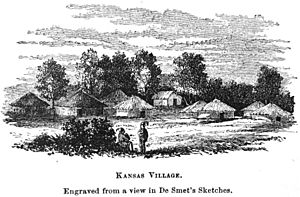
From 1780 to 1830, the Kaw lived at Blue Earth Village on the Kansas River, where Manhattan, Kansas is today. The Kaw likely moved to the Kansas River Valley to be closer to the large buffalo herds on the Great Plains. The tribe started to rely more on buffalo hunting for food and less on farming. Living on the Kansas River also gave them access to many fur-bearing animals. They could trade these furs with the French for guns and other goods.
However, moving west also made them more open to attacks from powerful enemies like the Pawnees. Lewis and Clark noted that the Kaw were "reduced by war with their neighbors." They estimated the Kaw population at about 1,500 people.
In 1811, traveler George C. Sibley described the Kaw favorably. He visited their village where the Big Blue River meets the Kansas River. He wrote, "The town contains 128 houses, or lodges, which are generally about sixty feet long and twenty-five feet wide...They are comfortable."
The Kaw were led by a chief and respected warriors. They were often at war with their neighbors, except for the Osage, with whom they had a strong friendship. Sibley described the Kansas as "stout, hardy, handsome," and "more active and enterprising even than the Osage." They were known for their bravery.
The Kaw lived in their village for about half the year. The women grew corn. For the other half of the year, they traveled to western Kansas to hunt buffalo, living in teepees. Horse racing and hunting were very important to the men. The Kaw were seen as traditional and resistant to change.
Dealing with the United States
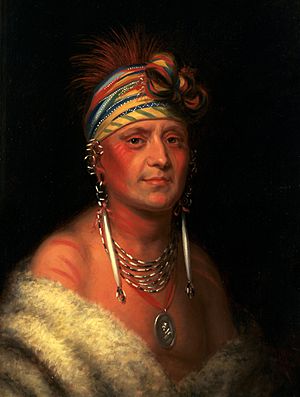
When the United States bought the Louisiana Territory in 1803, it had a very difficult impact on the Kaw. They became increasingly squeezed between Eastern Native American tribes forced to move west and White settlers who wanted the Kaw's rich lands. To the west of the Kaw were the Cheyenne and Comanche, and to the north were the Pawnee, who were their long-time enemies.
In 1825, the Kaw gave up a large area of land in Missouri and Kansas to the United States. In return, the U.S. promised to pay them $3,500 each year for twenty years. This payment, meant to be in goods and services, often arrived late or was taken by dishonest government officials and traders. The Kaw were not interested in the government's and missionaries' requests for them to become full-time farmers.
The Kaw also faced smallpox epidemics in 1827–1828 and 1831–1832, which killed about 500 people. During this time, the tribe split into four groups. This happened because of disagreements between three groups who wanted to keep traditional ways and one group led by White Plume who wanted to work with the United States. This latter group included 23 mixed-blood individuals, who were the children of French traders and Kaw women. French family names like Pappan, Bellmard, and Chouteau are still common among the Kaw today.
A terrible flood in 1844 destroyed most of the Kaw's crops, leaving the tribe very poor. In 1846, the Kaw sold most of their remaining 2,000,000 acres (8,100 km2) of land for $202,000. They received a 256,000-acre (1,040 km2) reservation near Council Grove, Kansas. Council Grove was a beautiful area, but it was a bad choice for the struggling tribe. It was a popular stop for rough travelers and traders on the Santa Fe Trail. The first Kaw people who arrived there were even attacked by traders. The illegal whiskey trade in Council Grove also caused many problems. White settlers moved onto Native American lands, and efforts by soldiers to remove them were not successful. By 1860, the Kaw reservation had shrunk to 80,000 acres (320 km2) due to settlers.
When the American Civil War began in 1861, the Kaw and other Native Americans in Kansas became important. The state asked them to serve as soldiers and scouts to help protect against attacks from slave-holding tribes and Confederate supporters. Seventy young Kaw men joined Company L, Ninth Kansas Cavalry. They served in Oklahoma and Arkansas during the war, and 21 of them died. This was a big loss for the tribe, whose numbers were already low.
After the war, European-Americans in Kansas pushed for the removal of Native Americans, including the Kaw. However, one exciting event happened during this difficult time. The Kaw and the Cheyenne had been enemies for a long time. On June 1, 1868, about one hundred Cheyenne warriors attacked the Kaw reservation. Frightened white settlers hid in Council Grove. The Kaw men painted their faces, put on their best clothes, and rode out on horseback to meet the Cheyenne. The two groups put on a show of horsemanship, loud shouts, and volleys of bullets and arrows. After four hours, the Cheyenne left with a few stolen horses and some coffee and sugar given to them by the Council Grove merchants. No one was hurt on either side.
During this event, a mixed-blood Kaw interpreter named Joseph James, Jr. (also known as Jojim or Joe Jim) rode 60 miles to Topeka to ask the Governor for help. With Jojim was an eight-year-old boy named Charles Curtis, who was part Native American. Curtis later became a jockey, a lawyer, a politician, and even the Vice President of the United States.
White pressure finally forced the Kaw out of Kansas. On June 4, 1873, they packed their belongings into wagons and headed south to Indian Territory (now Oklahoma) to a new reservation. Two weeks later, 533 Kaw people arrived at the Arkansas River and Beaver Creek in what would become Kay County, Oklahoma. That winter, the Kaw made their last successful buffalo hunt, riding to the Great Salt Plains. They dried the buffalo meat and sold the buffalo hides for five thousand dollars.
The Kaw population continued to decrease in Oklahoma. In 1879, their agent reported that almost half of the tribe had died from diseases in the previous seven years. In the 1880s and 1890s, the Kaw earned much of their money by leasing their land to White ranchers for grazing. In 1884, to manage these leases, they elected a government with a Chief Councilor and a representative from each of the four Kaw bands: Picayune, Koholo, Rock Creek, and Half-breed. Washungah was elected Chief Councilor in 1885, and the tribal headquarters was later named Washunga in his honor.
The 20th Century and Beyond
The Kaw found some safety from harassment on their Indian Territory lands, but the tribe's numbers continued to decline, especially among full-blood members. By 1888, there were only 188 Kaw people, and it seemed the tribe might disappear. However, they slowly adapted, and their numbers grew, mostly through intermarriage, even as the number of full-bloods kept decreasing. By 1910, only one elderly woman in the tribe could not speak English, and more than 80 percent could read and write.
The Curtis Act of 1898 gave the federal government more power over Native American affairs. The author of this act was Charles Curtis, who was now a Congressman. Curtis believed that Native Americans should adopt American ways. He supported breaking up tribal governments and dividing tribal lands among individual members, a process called allotment. In 1902, because of Curtis's efforts, Congress ended the Kaw tribal government and reservation. They divided the tribal lands among the members. Each of the 247 Kaw tribal members received 405 acres (1.6 km2), with 160 acres (0.6 km2) for a personal homestead. Curtis and his children received 1,620 acres (6.6 km2) of land. Most Kaw people later sold or lost their land. By 1945, only 13 percent of the former Kaw Reservation land was still owned by Kaw people.
Much of the former Kaw land was covered by water when Kaw Lake was created in the 1960s. Their Council House and cemetery at Washunga had to be moved to Newkirk, Oklahoma.
After Chief Washunga died in 1908, the Kaw people did not have a formal organization for many years. In 1922, Washunga's adopted daughter Lucy Tayiah Eads (Little Deer) was elected principal chief, along with a council of eight members. She was the first and only female chief. However, in 1928, the government agency for the Kaw was closed, and its buildings were sold. After that, the Kaw had no recognized government until the tribe was officially recognized and reorganized by the federal government in 1959.
In 1990, the Kaw approved a new tribal constitution. In 1992, they created a tribal court. In 2000, the tribe bought back land on their pre-1873 reservation near Council Grove, Kansas. They created a park there called the Allegawaho Memorial Heritage Park to remember their history in Kansas.
The last person who spoke the Kansa language fluently, Walter Kekahbah, died in 1983. As of 2012, the Kaw Nation offers online language learning for people who want to learn Kansa as a second language.
The last full-blood Kaw, William Mehojah, died in 2000.
Notable Kaw People
- Allegawaho (around 1820 – around 1897), was a Kaw Chief from 1867 to 1873. The Allegawaho Heritage Memorial Park in Council Grove, Kansas is named after him.
- Charles Curtis was the only Native American to become Vice President of the United States (serving under Herbert Hoover from 1929–1933). His career in Congress was also very important. Curtis served many terms in both the House and Senate, where he was a leader, showing his skill in managing laws and making agreements. Curtis's mother, Ellen Pappan Curtis, had Kaw, Osage, Potawatomi, and French ancestry. Curtis was officially enrolled as a Kaw tribal member.
- Lucy Tayiah Eads (born 1888) was the adopted daughter of Chief Washunga. She was elected Chief of the Kaw in the 1920s and worked to get federal recognition for the tribe.
- Joseph James and Joseph James, Jr. (Joe Jim or Jojim) were important interpreters and guides in the 1800s.
- William A. Mehojah was the last full-blood Kaw. He died on April 23, 2000. The Allegawaho Memorial Heritage Park (AMHP) was dedicated in his name on June 19, 2005, near Council Grove, Kansas.
- Jim Pepper was a U.S. jazz saxophonist, singer, and composer. He had both Kaw and Creek ancestry.
- Washunga was the main chief of the Kaw from 1873 until he died in 1908. Washunga, Oklahoma was named after him.
- White Plume (also known as Monchousia) was a Kaw Chief who visited President Monroe in Washington D.C. in 1822.
- Mark Branch is a two-time NCAA-champion wrestler and a wrestling coach at the University of Wyoming. He won NCAA championships in 1994 and 1997.
- Chris Pappan is a talented ledger artist.
|


